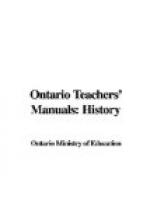NOTE.—The teacher may refer to some of the modern social problems resulting in large part from this industrializing of the country: overcrowding in cities, bad housing and slums, urban and suburban transportation, educational problems, intemperance, decrease in physique, etc. (For the history of this period, see A History of the British Nation, by A.D. Innes, T.C. & E.C. Jack, Edinburgh.)
THE ROAD TO CATHAY
The aim of this lesson is to show how the desire of certain European nations to find a western route to the rich countries of the East—India, Cathay, and Cipango (India, China, and Japan)—led to the discovery and subsequent exploration of America. It can be used as a review lesson on the exploration of Canada. It will also give the pupil practice in collecting information from various sources so as to show the development of history along a certain line.
The subject-matter may be divided into as many lessons as the teacher thinks best, and the oral method should be used. All the dates given are not intended to be memorized; they are used to show the historical sequence; only three or four of the most important need be committed to memory by the class at their present stage. The map should be used frequently.
THE LESSON
One of the results of the Crusades was to reveal to the European nations the wealth of the East. Trade between the East and West grew, and Venice became one of the wealthiest and most powerful of the states of Europe.
In 1295, a Venetian traveller named Marco Polo returned from Cathay after an absence of twenty-five years. His stories of the wealth in silks, spices, pearls, etc., of those eastern countries intensified the desire of the West to trade with them. A great commerce soon grew up, carried on principally by the great Italian cities—Venice, Florence, Genoa, Pisa, Milan—and as these cities controlled the Mediterranean, the only route to Asia then known, they had a monopoly of the Eastern trade, and kept for a time the other western nations—Spain, Portugal, France, and England—from sharing in it. These nations, animated by the hope of gain and by the spirit of adventure and exploration, could not long be denied their share. This spirit was stimulated by the introduction of the mariner’s compass, which afforded sailors a safer guide than landmarks and stars; by the invention of gunpowder and the use of cannon, which, through lessening the strength of the mediaeval castle, tended to increase the power of the middle classes; and by the invention of printing, which aided greatly in the diffusion of knowledge.
The problem was to find a route by which to trade with India and China.




